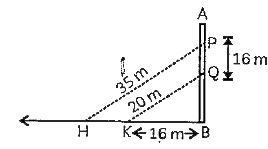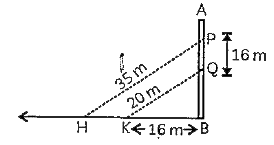Two spotlights, P and Q are mounted on a vertical pole AB as shown.
Light beams from P and Q shine to two points on the ground, H and K, respectively. Given that PQ = 16m, KB = 16m, PH = 35m and QK = 20m, Find:
HK, the distance between the projections of the light beams.
The correct Answer is:5m
To solve the problem, we need to find the distance HK, which is the distance between the projections of the light beams from points P and Q to the ground at points H and K respectively.
1. Identify the Given Values:
- PQ = 16 m (distance between the two spotlights)
- KB = 16 m (distance from point K to point B, the base of the pole)
- PH = 35 m (distance from point P to point H)
- QK = 20 m (distance from point Q to point K)
2. Find BQ using Triangle QBK:
- Since triangle QBK is a right triangle, we can apply the Pythagorean theorem:
BQ2=QK2−KB2
- Substitute the values:
BQ2=202−162
BQ2=400−256=144
- Therefore, taking the square root:
BQ=√144=12 m
3. Find HB using Triangle PBH:
- Now, we will use triangle PBH to find HB. Again, we apply the Pythagorean theorem:
PH2=PB2+HB2
- We know PH = 35 m and PB = BQ = 12 m (since PB is the same as BQ):
352=122+HB2
1225=144+HB2
- Rearranging gives:
HB2=1225−144=1081
- Taking the square root:
HB=√1081≈32.9 m
4. Calculate HK:
- Finally, we can find HK:
HK=HB−KB
- Substitute the values:
HK=32.9−16=16.9 m
Final Answer:
The distance HK is approximately 16.9 m.
- PQ = 16 m (distance between the two spotlights)
- KB = 16 m (distance from point K to point B, the base of the pole)
- PH = 35 m (distance from point P to point H)
- QK = 20 m (distance from point Q to point K)
- Since triangle QBK is a right triangle, we can apply the Pythagorean theorem:
BQ2=QK2−KB2
- Substitute the values:
BQ2=202−162
BQ2=400−256=144
- Therefore, taking the square root:
BQ=√144=12 m
- Now, we will use triangle PBH to find HB. Again, we apply the Pythagorean theorem:
PH2=PB2+HB2
- We know PH = 35 m and PB = BQ = 12 m (since PB is the same as BQ):
352=122+HB2
1225=144+HB2
- Rearranging gives:
HB2=1225−144=1081
- Taking the square root:
HB=√1081≈32.9 m
- Finally, we can find HK:
HK=HB−KB
- Substitute the values:
HK=32.9−16=16.9 m
The distance HK is approximately 16.9 m.
Similar Questions
Knowledge Check
Let AB and CD are two parallel
chords of circle whose radius is
5 units. If P and Q are mid points
of AB and CD respectively such that
P.A.PB=9,QC.QD=16,
then distance between AB and CD isA5B25C7D11Let AB be a vertical pole placed at point A on the ground. P and Q are two points on the ground such that points A, P and Q are collinear. Angles of elevation of ponit B (top of pole) from P and Q are 30∘ and 45∘ respectively. If distance P and Q is 2m, then height ofthe pole is
A(√3+1)mB(√3−1)mC2mD1m
In ABC , points P and Q are on CA and CB , respectively such that CA=16cm , CP=10cm , CB=30cm and CQ=25cm . Is PQ∣∣AB ?
View SolutionA vertiacal pole is 60 m high, The angle of depression of two points P and Q on the ground are 30∘and45∘ respectively. If the points P and Q lie on either side of the pole, then find the distance PQ.
View SolutionThe intensities of a magnetic field at two points on the axis of a bar magnet at distance of 0.15m and 0.2m from its middle point are in the ratio 75:20. Find the distance between the poles of the magnet.
View SolutionLet AP and BQ be two vertical poles at points A and B respectively. If AP=16m, BQ=22m and AB=20m , then find the distance of a point R on AB from the point A such that RP2+RQ2 is minimum.
View SolutionThe playground of our school is in the shape of a quadrilateral ABCD. A flagpost standing vertically in the ground subtends angles of 45∘and30∘ at two points P and Q, which lie on the sides AB and AD respectively such that AP = 50 m and AQ = 30 m. If P and Q are the nearest points on the sides AB and AD to the flagpost, then the height of the flagpost is :
View SolutionLet AP and BQ be two vertical poles at points A and B, respectively. If AP=16m,BQ=22mandAB=20m, then find the distance of a point R on AB from the point A such that RP2+RQ2is minimum.
View Solution


